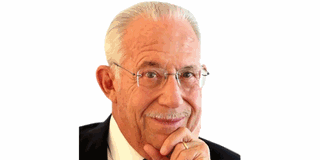Prime
Health messaging in disinformation age

Author, William A Haseltine. PHOTO/COURTESY
What you need to know:
- Successful public-health communication establishes credibility by being effective, not by being unchanging.
As the director of the Centers for Disease Control and Prevention (CDC), Rochelle Walensky, recently acknowledged, poor public-health communication and messaging throughout the Covid-19 pandemic has damaged the public’s trust in health agencies and institutions. This, in turn, contributed to well-known problems such as vaccine hesitancy, noncompliance with mask recommendations and other protective measures, and general misinformation about the virus and how it is transmitted.
According to a 2021 poll from the Robert Wood Johnson Foundation and the Harvard T.H. Chan School of Public Health, only 52 percent of Americans now place a great deal of trust in the CDC, and only 37 percent have much confidence in the National Institutes of Health or the Food and Drug Administration. State health departments fare little better.
Clearly, public-health agencies need to win back the public’s trust, not just to combat crises like Covid-19 and monkeypox, but also to address a wider range of ongoing health issues. This process must start with a commitment to community engagement, partnerships across other sectors such as housing and education, effective communication at every level, and transparency and integrity in decision-making.
Public-health officials often must base their recommendations on incomplete data; as the data evolve, so will the recommendations.
A perfect example is the early advice on how SARS-CoV-2 is transmitted. The CDC was adamant that the coronavirus was spreading on surfaces and not through the air, rather than acknowledging that airborne transmission was still a strong possibility. This approach bred confusion and distrust, because the CDC eventually had to change its advice (as it should have foreseen). After acknowledging that SARS-CoV-2 was spreading through droplets, it finally also conceded that it was spreading through aerosol particles.
As this example shows, credibility often gets confused with infallibility, resulting in public-health officials who may be slow to admit mistakes – further undermining their credibility. Transparency is key, especially at a time when peddlers of online misinformation will seize every opportunity to discredit public-health officials.
Another cornerstone of sound communication is clarity. Public-health officials must explain how data and recommendations relate to people’s everyday lives. Whether the information is correct or incorrect is a moot question if the public doesn’t understand what is being communicated.
Here, US officials failed the messaging test again when they did not make clear that Covid-19 vaccines’ effectiveness was measured by hospitalisations, not infections. The public believed that vaccines would block transmission and infection; but when the Delta and Omicron variants emerged and caused breakthrough infections to surge, distrust and “booster-shot fatigue” duly followed. As of August 3, only 32 percent of Americans had received their first booster shot.
In this case, public-health officials could have used the example of the Salk polio vaccine to assure the public that a vaccine doesn’t need to prevent infection or transmission outright to eradicate a disease. Or, they could have emphasised how much the vaccines reduce the burden on our hospitals.
Public-health messages are best understood and most likely to be believed when they come from trusted individuals within the communities that need to be reached. The messenger is often as important as the message, especially in communities where structural racism and historical traumas have left people disinclined to trust medical authorities.
Rather than issuing authoritative statements and assuming that they will be heeded, local public-health officials should think of their messaging as being part of an inclusive conversation.
-- Project Syndicate




